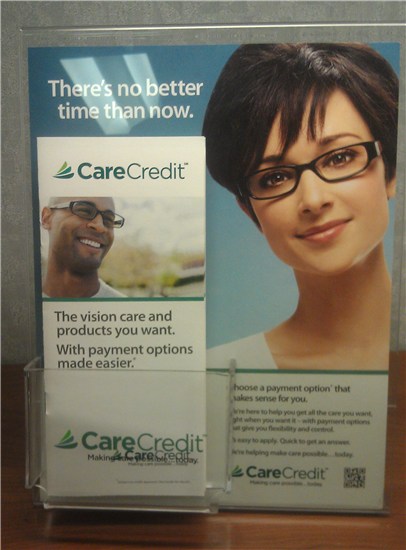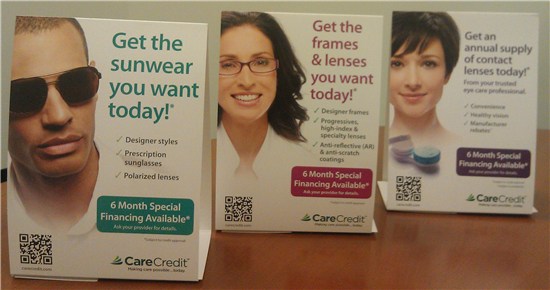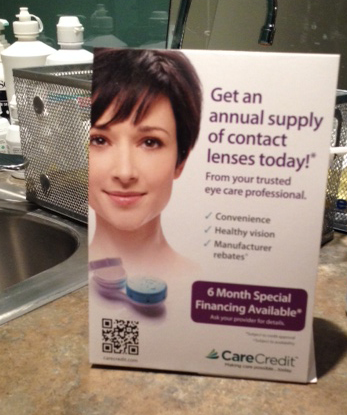By Gina M. Wesley, OD, MS, FAAO 
SYNOPSIS
Providing patients withfinancing options is a welcome service that can boost revenues. A provider rep can help to train your staff to make effective presentations.
ACTION POINTS
SET A GOAL. In our office, we aim to double use of financing to 30 percent.
TRAIN STAFF TO PRESENTFINANCING. Afinancing rep can train your staff ontalking pointswith patients.
LET PATIENTS KNOW FINANCING OPTION. Introduce financing with POP materials, reinforce with staff scripting.
Patient financing via companies such as CareCredit can help your patients purchase the products, and have the services, you recommend for them. But first, you must know how to best communicate the benefits of financing to patients. Working with your staff to ensure all patients understand they can use financing as a tool for purchases and services is a practice-builder and patient loyalty enhancer. Here is how my practice is working to improve in this area.

The brochure Dr. Wesley uses to educate patients about the benefits of financing.
Patient Finance Users Spend 10 Percent More in My Practice
I recently noticed we could be doing a much better job. I would estimate that only 15 percent of my patients use CareCredit at my office, and I would like to see that number grow to 30 percent or more. As I just discussed with my staff, the ideal situation (based on rates/fees we have to pay) is that someone pays cash for a purchase. After that, use of a credit card, whether it is their general purpose card or the CareCredit credit card. However, when we look at the average purchase for our CareCredit users, it’s about 10 percent+ higher than a non-CareCredit user. This more than makes up for the slightly higher transaction fee we pay when patients use this card.
Create Financing Parameters
Once patients use CareCredit at our office, they know they can continue to use it as long as they have credit available, and it becomes ingrained with their purchases, whether it be services or products. With CareCredit, purchases of $200 or more are eligible for special financing, and we utilize the six-month no interest if paid in full special financing option only. We’ve decided to move in this direction to make it easier for all involved, but I know of many practices that use the 12-month deferred interest financing option as well (at a higher transaction fee).
As I mentioned above, CareCredit IS a revenue generator because you’ve now found a way to help a patient fit their purchase into their every-day spending and budget (paying something off monthly). Additionally, there is no annual fee; the benefit being spreading payment out over six months instead of all at once. Of course, the patient does need to pay their balance off in full by the end of the promotional period or they will be charged interest, starting from the date of purchase.
Have Patient Financing Provider Train Staff
I would advise utilizing CareCredit’s team for training. It was easy for us to arrange training via a webinar. What this has done is again remind the staff of how to introduce CareCredit to patients, let them apply in-office, and handle the transactions. It also educated them on how to handle possible refunds and other issues. It essentially made the financing option top-of-mind once again, as I had felt it slipped a little over time.

A counter card in Dr. Wesley’s office advertises the benefits of six-month financing to facilitate purchases.
After this latest round of training, all staff is prepared to discuss CareCredit at any time, especially if a patient mentions concern about paying for services or products. They might say to patients: “We offer a special financing option for our patients with the CareCredit credit card. Would you like to hear more about that option?” At the very least saying something like this lets the patient know there are options, and at the most, it opens them up to applying for CareCredit. Typically, the discussion is most often brought up by my opticians as they are the ones to check patients out with services, optical and contact lens purchases. We also have signage throughout the office and on our web site that lets patients know we accept CareCredit.
Have the Conversation with Patients
When a patient is ready to purchase, the optician gives them a total dollar amount due out of pocket. They then ask, “How would you like to pay for that?” and then explain that CareCredit would be an option. We have in-office POP that shows a breakdown of what a typical range of purchase amounts would be when broken down over six months. The optician can point this out and tell the patient that CareCredit is a health-related credit card that would allow them to do this. We then explain that CareCredit is accepted at other places, too, including dentists, veterinarians and other types of healthcare practices.
I mention CareCredit in the exam room if a patient expresses concern about the cost of the products or services I’ve recommended. If a patient says they are concerned about paying for what I’ve prescribed, I simply tell them we have financing options with no interest if paid in full within six months, and that my staff can explain more. I try not to discuss money too much with patients, as I feel that it compromises my clinical time and expertise with patients.
Truthfully, the staff knows more about pricing in the office anyway. After I’ve determined what fees should be, I purposefully remain somewhat ignorant about applying them to memory, so I’m not biased in what products and services I’m offering to patients. I want to recommend what’s best for them regardless of cost, and then allow them to make an educated decision about choosing to pursue my prescriptions. CareCredit is a part of that process.
Training & Marketing Resources
Scripting for Success–Presenting the CareCredit Healthcare Credit Card
Direct Vision Care Mail Insert for CareCredit Providers
Direct Optical Dispensary Mail Insert for CareCredit Providers

A counter card in Dr. Wesley’s office educates patients about purchasing an annual supply of contact lenses using patient financing.
Related ROB Articles
Patient Financing: Your Second-Pair Sales Tool
Build Patient Purchases with Financing Options
Patient Financing: Your Marketing Advantage
Gina M. Wesley, OD, MS, FAAO, is the owner of Complete Eye Care of Medina in Medina, Minn. To contact her: drwesley@cecofmedina.com.



























